Fedex Has Announced It Will Continue It s Relationship With Nra

At the National Rifle Association's (NRA) annual leadership forum in Atlanta in April 2017, thousands of attendees erupted into applause as President Donald Trump took the stage to thank the organization for its support during his successful 2016 presidential campaign [source: Shear].
"You came through for me, and I am going to come through for you," Trump promised, according to a transcript of his remarks.
Indeed, the NRA — an organization with nearly 5 million members — had worked hard to help elect Trump. At one crucial moment in the campaign in early October, for example, the organization reportedly spent $6.5 million on a 30-second television spot, which ran on national cable channels and broadcast networks in critical battleground states like Ohio, Nevada and Virginia. In the ad, a woman who used a pistol in her purse to defend herself from a knife-wielding attacker compared Trump favorably to his opponent Democrat Hillary Clinton, a supporter of stricter gun control laws. "Donald Trump supports my right to own a gun," the woman proclaimed [source: Wheaton].
According to one analysis, in addition to spending $30.3 million to support Trump, the NRA put another $20 million into six competitive U.S. Senate races in 2016, and its favored candidates — all Republicans — all prevailed [source: Spies and Balcerzak].
Trump showed his gratitude by becoming the first sitting president in 34 years to address the NRA gathering [source: Parks]. The appearance was an indication of how far the NRA — founded in 1871 by two former Union Army officers who wanted to improve Americans' marksmanship — had come as potent political force in fighting restrictions on gun rights. It wasn't just money that helped the NRA to win elections. As George Stephanopoulos, the TV newsman and former adviser to President Bill Clinton, once explained, "Let me make one small vote for the NRA. They're good citizens. They call their congressmen. They write. They vote. They contribute. And they get what they want over time" [source: Sottile].
In addition to its political advocacy, the NRA — which had a budget of $303.5 million in 2015, according to its tax return — does plenty of other things to support gun ownership in the U.S. [source: ProPublica]. About 1 million people a year attend its firearms courses, and the organization proclaims itself to be "the gold standard" in gun safety training [source: NRA]. It also promotes recreational sport shooting competitions at 11,000 sanctioned events [source: NRA] And the organization even markets insurance policies (called NRA Carry Guard) for those who arm themselves for self-defense, providing them with as much as $1 million in coverage to defray the costs of defending civil lawsuits.
In this article, we'll look at the NRA's history and mission, and how it went from an organization primarily focused on marksmanship and hunting into one that has become a potent political force.
Mission of the NRA
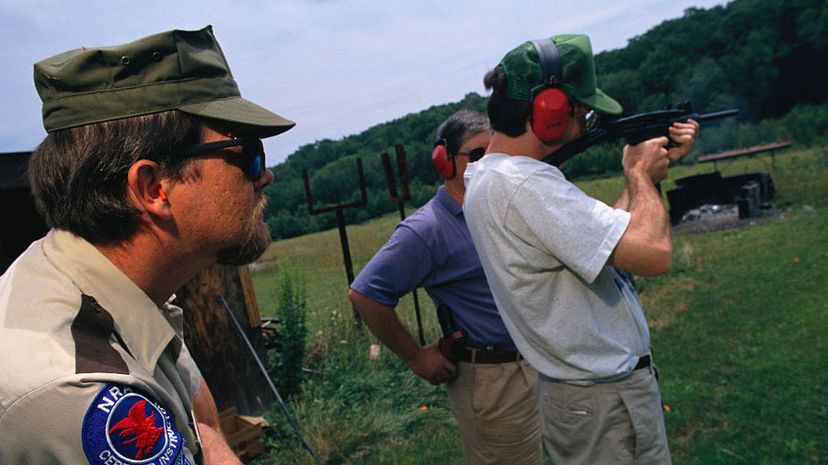
Article II of the NRA's bylaws describes the organization's purposes and objectives, and not surprisingly, at the top is protecting the right of American citizens "to acquire, possess, collect, exhibit, transport, carry, transfer ownership of, and enjoy the right to use arms" [source: GuideStar]. The NRA's Institute for Legislative Action, which was formed in 1975, takes the lead in such advocacy, spending nearly $24.9 million in 2015, according to the NRA's tax return [source: ProPublica].
The bylaws also spell out the NRA's other aims, including training members of law enforcement agencies, the armed forces and "people of good repute: in marksmanship and the safe handling and use of small arms." The organization also promotes sports shooting, such as amateur marksmanship competitions from the local to the international level, as well as hunter safety and the defense of the sport of hunting as necessary to wildlife conservation [source: GuideStar]. According to its 2015 tax return, the NRA spent $45.4 million on its training courses and promotion of competitive shooting and hunting [source: ProPublica].
The organization has certified 125,000 firearms instructors who train about 1 million gun owners a year, with courses available in basic rifle, pistol, shotgun, muzzle-loading firearms and ammunition reloading, according to the NRA website. Since 1988, it also has run the Eddie Eagle GunSafe Program, which aims to educate fourth-grade students on what to do if they happen upon a firearm in an unsupervised situation.
The NRA also spent about $35.5 million in 2015 on membership support, which included what its tax return describes as "a growing multimedia platform" of four official journals for members, plus other magazines and digital channels aimed at different subsets of the gun-owning population, like women. A key part of that sprawling media operation is NRA TV, a website that features pro-gun rights video commentaries sponsored by firearms manufacturers [source: Yablon].
History of the NRA
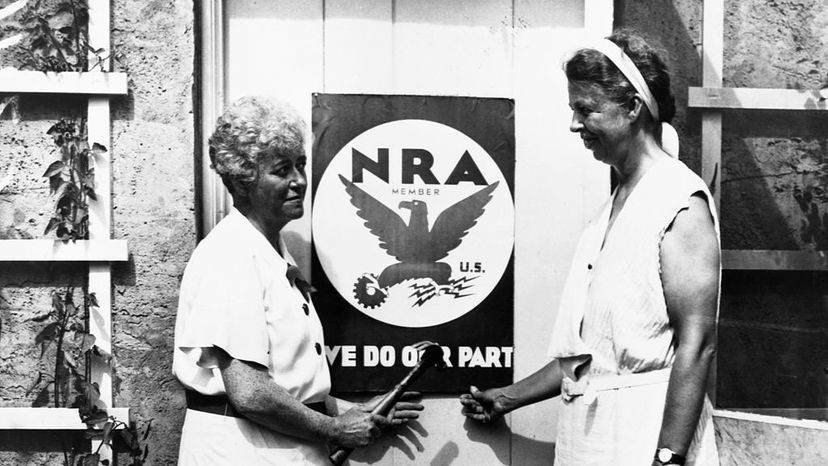
Though today's NRA is strongly focused on protecting citizens' rights to own gun rights, the organization began with a different aim. Its founders were two Union Army veterans, Col. William C. Church and Gen. George Wingate, who were disturbed by the poor marksmanship skills of their troops during the Civil War. In an 1871 article for Army and Navy Journal, Church wrote that the National Guard wasn't doing enough to improve soldiers' shooting, and so he favored setting up an organization modeled after one in Great Britain — also called the National Rifle Association, interestingly — "to promote and encourage rifle-shooting on a scientific basis" [sources: Church, NRA, Rothman].
That same year, the American NRA was formed. Another former Union officer — Gen. Ambrose Burnside, who also served as Rhode Island governor and as a U.S. senator from that state, was the organization's first president [source: NRA].
The following year, with financial help from New York state, the NRA established a practice site at the Creed Farm in Long Island. Creedmoor, as the range was named, was the site of the organization's first annual shooting competition. But eventually, according to history on the NRA's website, political opposition to target shooting forced the NRA to find a new location. In 1892, Creedmoor was deeded back to the state, and the NRA moved its competitions to Sea Girt, New Jersey.
In the early 1900s, the NRA continued to promote shooting, with NRA Secretary Albert S. Jones urging universities and military academies to form rifle clubs. The organization also had its own youth program, and in the summer of 1906, 200 boys competed in matches at Sea Girt. With participation in the NRA's shooting programs growing, though, a bigger facility was needed, and Camp Perry, established on the shores of Lake Erie in Ohio by Gen. Ammon B. Crichfield, became the home of the National Matches, a shooting competition that today attracts nearly 6,000 competitors in various events [source: NRA].
During World War II, as might be expected from an organization founded by army generals, the NRA played a role in the war effort, offering its ranges to the government, developing training materials and encouraging members to help guard defense plants. The organization even collected 7,000 firearms and shipped them to Great Britain to help that country prepare for a possible German invasion. (The NRA notes that Great Britain had virtually disarmed itself between World Wars I and II due to gun control laws.)
After the war, the NRA shifted its focus to safety training and education for hunters. In 1949, it worked with New York state to establish the first hunter education program, and similar programs followed across the U.S. and in Canada. In 1960, the NRA also launched a firearms instructor certification program for police officers, and in 2018, there are more than 13,000 NRA-certified policy and security instructors across the nation [source: NRA].
Eventually, though, the NRA would become more prominent for its political activism.
How Did the NRA Evolve Into an Activist Organization?
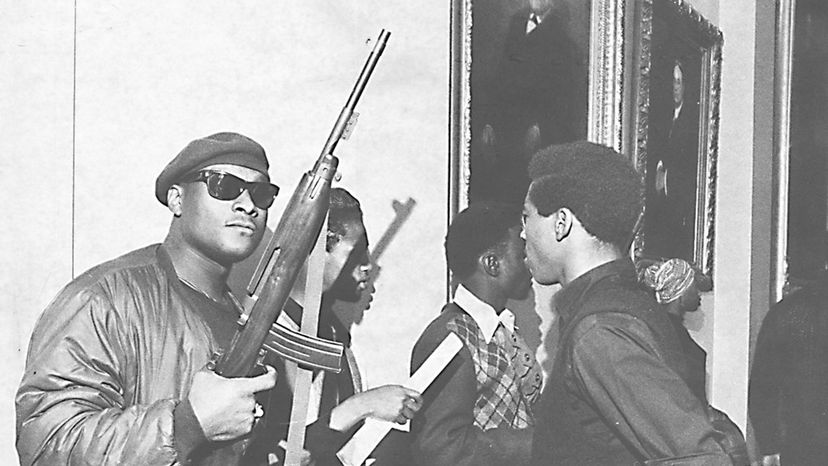
The Second Amendment to the U.S. Constitution states, "A well regulated Militia, being necessary to the security of a free State, the right of the people to keep and bear Arms, shall not be infringed" [source: National Archives]. Scholars have debated what exactly was the Constitutional framers' intent with regard to the average American owning a gun. But the world is obviously a different place now than it was in the 18th century when this amendment passed, and many politicians believe that gun ownership should be restricted and regulated.
When the U.S. Senate Judiciary Committee held hearings in January 2013 in the aftermath of Sandy Hook Elementary School shooting in Connecticut in which a mentally ill young man armed with a military-style semiautomatic AR-15 rifle and two semiautomatic handguns killed 20 children and six adults, NRA executive vice president and CEO Wayne LaPierre appeared to argue against new firearms restrictions. "Law-abiding gun owners will not accept blame for the acts of violent or deranged criminals," LaPierre testified. "Nor do we believe the government should dictate what we can lawfully own and use to protect our families" [source: Judiciary].
But the NRA wasn't always opposed to new gun control legislation. In fact, there was a time, in the 1920s and 1930s, when the organization helped to write it. The then-NRA president Karl T. Frederick, a former Olympic champion pistol shooter, helped to draft the Uniform Firearms Act, a model for state gun laws, in which police permits were required for carrying concealed handguns, gun dealers had to report sales to law enforcement agencies and a two-day waiting period was imposed on sales [source: Winkler].
In congressional testimony about the National Firearm Act of 1934, which required federal registration of weapons such as machine guns and sawed-off rifles, Frederick said that while he didn't believe "in the general promiscuous toting of guns," he was opposed to the law. This was not because he was against gun control but because he thought from a constitutional standpoint it should be left to the states [source: Shamaya].
In the 1960s, the NRA actually supported new federal gun laws. In 1963, Lee Harvey Oswald bought the rifle used to assassinate President John F. Kennedy from a mail order ad in an NRA magazine. The NRA's executive vice president at the time, Franklin Orth, testified to Congress in favor of banning mail-order rifle sales, and gave measured support to the Gun Control Act of 1968, saying that although it was "unduly restrictive" for law-abiding citizens, the law "appears to be one that the sportsmen of America can live with." With the rise of the Black Panther Party whose members openly toted weapons, some NRA members were concerned about guns getting in the "wrong hands." The Gun Control Act cut down on the importation of "Saturday Night Specials" often used in urban crime [source: Winkler].
But in the 1970s, the NRA's politics began to shift, as gun owners increasingly became people who bought firearms for protection rather than for sports. In 1976, the then-EVP announced that the NRA was leaving Washington as it was retreating from lobbying to concentrate on promoting recreational shooting [source: Winkler]. This was too much for the new breed of activists. At the NRA's annual convention in Cincinnati in 1977, a grass-roots insurgency ousted the existing leadership and took the NRA in a more stridently anti-regulatory direction [source: Achenbach, Higham and Horowitz]
The NRA's switch coincided with a time when changes in campaign finance regulations made it easier to infuse money into politics. The NRA soon became a formidable fundraising juggernaut — in the words of National Public Radio news analyst Ron Elving, "making and breaking candidacies at the state and federal level." It's continued to exert that influence ever since.
How Influential Is the NRA?
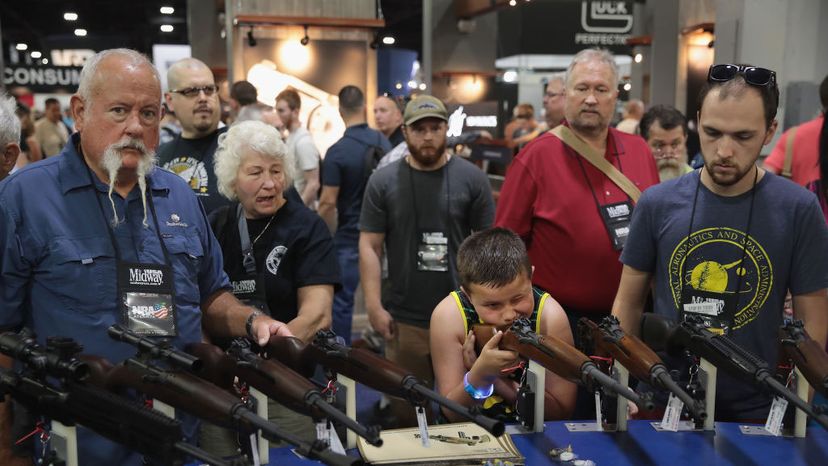
The NRA has been successful in helping to elect candidates who share its opposition to restricting Second Amendment rights, but it hasn't converted a majority of the American public to its view. Gallup polling from October 2017 showed that 60 percent of Americans think that laws covering the sale of firearms should be made stricter, with 33 percent saying they should be kept as they are now, and only 5 percent favoring loosening restrictions [source: Gallup].
NRA members tend to be more conservative than the American public, and even more so than other gun owners. According to a 2017 Pew Research Center poll, 77 percent of NRA members are Republicans or lean Republican, compared to 58 percent of gun owners who don't belong to the NRA. (Only 20 percent of NRA members are Democrats or lean Democrat.) Pew found that NRA members are more likely to own five or more weapons (52 percent) than non-NRA gun owners (24 percent), and they're more likely to have a gun loaded and accessible to them at all times (53 percent versus 34 percent for non-NRA gun owners). Additionally, 45 percent of the NRA members surveyed said that owning a gun is very important to their overall identity, compared to 20 percent of non-NRA gun owners [source: Pew].
Pew also found that NRA members, while generally for less legal restrictions on weaponry, weren't completely monolithic in their opposition to gun control. Eighty-eight percent favored allowing concealed carry of guns in more places, while 73 percent favored shortening waiting periods for purchase. But 79 percent favored preventing mentally ill people from buying guns, and 72 percent favored barring gun purchases by people on federal no-fly or watch lists. And a bare majority of 52 percent even favored requiring background checks for private gun sales and transactions at gun shows, a loophole that many gun control advocates want to close.
Sixty-three percent of NRA members thought the organization had the right amount of influence over gun laws in the U.S., and another 28 percent said it had too little influence. Only 9 percent felt it had too much influence. Meanwhile 50 percent of non-gun owners thought the NRA had too much influence and 34 percent felt it had the right amount [source: Pew].
Joining the NRA
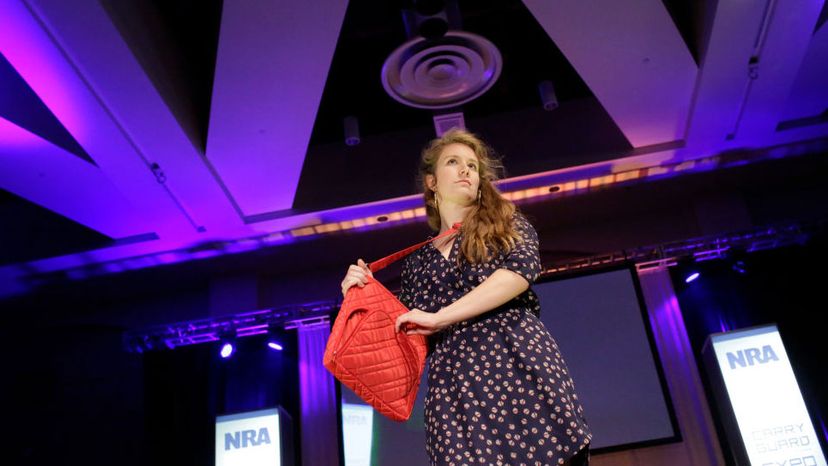
So, what is the NRA all about? Let's quote from the NRA's own membership webpage: "The NRA is America's preeminent gun rights organization, made up of nearly five million members. Together, we fight and win the toughest battles for the Second Amendment, all while offering the best firearms educational programs in the country.
Every day, the NRA fights back against politicians, judges, and bureaucrats who want to regulate, restrict, and ultimately, destroy your Second Amendment freedom."
As you can see, defending the Second Amendment is the NRA's primary mission, while other activities are secondary. If you agree with the NRA's mission and goals, joining is as simple as going to its website and filling out the online application. There are distinctions of membership to choose from:
- One-, two-, three- or five-year memberships (2018 fees range from $40-$140)
- Life membership (2018 cost is $1,500)
- Associate membership
- Youth membership
The NRA lists the following benefits for its members:
- "24/7 defense of your gun rights"
- Subscription to an NRA magazine of the member's choice
- Membership card and decal
- A $7,500 Gun Owner Protection Plan insurance policy
You also get to choose a thank-you gift, which may be a duffel bag, a cap or a knife — but no gun.
Lots More Information
Related Articles
- NRA Insurance Protects Gun Owners Shooting in Self-Defense
- Top 5 Most Popular Guns
- 10 Big Questions in the U.S. Gun Control Debate
- Do countries with stricter gun laws really have less crime or fewer homicides?
- Thought Experiment: What Would a World Without Guns Be Like?
More Great Links
- National Rifle Association
- Johns Hopkins University: Center for Gun Policy Research
- Second Amendment Foundation
- Brady Campaign to Prevent Gun Violence
Sources
- Achenbach, Joel; Higham, Scott; and Horowitz, Sari. "How NRA's true believers converted a marksmanship group into a mighty gun lobby." Washington Post. Jan. 12, 2013. (Dec. 3, 2017) http://wapo.st/2BG1XK3
- BBC News. "US gun control: What is the NRA and why is it so powerful?" BBC.com. Jan. 8, 2016. (Dec. 3, 2017) http://bbc.in/2kkHp5t
- Berkvist, Robert. "Charlton Heston, Epic Film Star and Voice of N.R.A., Dies at 84." New York Times. April 6, 2008. (Dec. 4, 2008). http://nyti.ms/2BHEVT7
- Bureau of Alcohol, Tobacco, Firearms and Explosives. "National Firearms Act." Dec. 1, 2016. (Dec. 3, 2017) http://bit.ly/2BJHN1Y
- Center for Responsive Politics. "National Rifle Assocation." Opensecrets.org. (Dec. 3, 2017) http://bit.ly/2kkJRsE
- Chilson, Morgan. "National Association for Gun Rights vs. NRA: How Do They Differ?" Newsmax. Oct. 12, 2014. (Dec. 3, 2017) http://nws.mx/2kl4TYt
- Church, W.C. "The National Guard." Army and Navy Journal. Aug. 12, 1971. (Dec. 4, 2017) http://bit.ly/2nr325f
- Economic Research Institute. "Form 990" (National Rifle Association 2015). Erierni.com. (Dec. 3, 2017)
- Ellis, Black and Hicken, Melanie. "The Money Powering the NRA." CNN.com. (Dec. 3, 2017) http://cnnmon.ie/2kiPQOQ
- Elving, Ron. "The NRA Wasn't Always Against Gun Restrictions." National Public Radio. Oct. 10, 2017. (Dec. 3, 2017) http://n.pr/2kjn3JW
- Fisher, Tyler; Frostenson, Sarah; and Mihalik, Lily. "The gun lobby: See how much your representative gets." Politico. Oct. 2, 2017. (Dec. 3, 2017) http://politi.co/2khq0ea
- Frankel, Joseph. "The Government Won't Fund Research on Gun Violence Because of NRA Lobbying." Newsweek. Oct. 2, 2017. (Dec. 3, 2017) http://www.newsweek.com/government-wont-fund-gun-research-stop-violence-because-nra-lobbying-675794
- Gallup News. "Guns." Gallup.com. (Dec. 3, 2017) http://news.gallup.com/poll/1645/guns.aspx
- Government Accountability Office. "Personal Firearms: Programs that Promote Safe Storage and Research on Their Effectiveness." Gao.gov. September 2017 (Dec. 3, 2017) http://bit.ly/2kjqwYY
- Guidestar.org. "National Rifle Association of America." Guidestar.org. (Dec. 3, 2017) https://www.guidestar.org/profile/53-0116130
- Guidestar.org. IRS Form 990 for National Rifle Association, 2015. Guidestar.org. (Dec. 3, 2017) http://bit.ly/2khi3pf
- Hickey, Walter. "How The Gun Industry Funnels Tens Of Millions Of Dollars To The NRA." Business Insider. Jan. 16, 2013. (Dec. 3, 2017) http://www.businessinsider.com/gun-industry-funds-nra-2013-1
- Maguire, Robert. "Audit shows NRA spending surged $100 million amidst pro-Trump push in 2016." Opensecrets.org. Nov. 15, 2017. (Dec. 3, 2017) http://bit.ly/2kkMA5p
- NRA. "Firearms Training." NRA. (Dec. 3, 2017) https://explore.NRA/interests/firearms-training/
- NRA Carry Guard. "America's Most Complete Self-Defense Insurance Program and Training for Those Who Carry a Gun." Nracarryguard.com. (Dec. 3, 2017) https://www.nracarryguard.com/
- NRA. National Rifle Association home page. NRA. (Dec. 3, 2017) https://home.NRA/
- NRA. "A Brief History of the NRA." NRA. (Dec. 3, 2017) http://bit.ly/2kkGzFP
- NRA. "Join the NRA." NRA. (Dec. 3, 2017) http://bit.ly/2kirTY4 12/09/2008).https://membership.nrahq.org/forms/signup.asp
- NRA. "Recreational Shooting." NRA. (Dec. 3, 2017) https://explore.NRA/interests/competitive-shooting/
- NRA. "Your NRA Benefits." NRA. (Dec. 3, 2017). http://bit.ly/2kj1SYy
- NRA Foundation. "About the NRA Foundation." Nrafoundation.org. (Dec. 3, 2017) http://bit.ly/2kisn0k
- NRA Institute for Legislative Action. "NRA-ILA." Nraila.org. March 9, 2008. (Dec. 3, 2017) https://www.nraila.org/articles/20080309/nra-ila-2
- Parker, Kim. "Among gun owners, NRA members have a unique set of views and experiences." Pew Research Center. July 5, 2017. (Dec. 3, 2017) http://pewrsr.ch/2kj4Egq
- Parks, Miles. "Trump Brings Campaign Rhetoric To NRA Speech, Pledging Gun-Rights Support." Npr.org. April 28, 2017. (Dec. 3, 2017) http://n.pr/2khCfax
- ProPublica Nonprofit Explorer. "National Rifle Association of America." Projects.propublica.org. (Dec. 3, 2017) http://bit.ly/2kfsw4q
- Rosenwald, Michael S. "The NRA once believed in gun control and had a leader who pushed for it." Washington Post, Oct. 6, 2017. (Dec. 3, 2017) http://wapo.st/2kjmi3y
- Rothman, Lily. "The Original Reason the NRA Was Founded." Time. Nov. 17, 2015. (Dec. 3, 2017) http://time.com/4106381/nra-1871-history/
- Rushe, Dominic. "The NRA is smaller than you'd think – so why does it wield such influence?" Guardian. Nov. 17, 2017. (Dec. 3, 2017) http://bit.ly/2kkA8mo
- Saad, Lydia. "More Now Favor New Gun Laws Over Stricter Enforcement." Gallup.com. Nov. 9, 2017. (Dec. 3, 2017) http://bit.ly/2knhuug
- Sag, Ansel; as told to Kerry Shaw. "The NRA Annoyed Me Into Quitting — But I Get Why Some Gun Owners See It as a 'Necessary Evil.'" The Trace. July 21, 2017. (Dec. 3, 2017) http://bit.ly/2kkvbKk
- Senate Judiciary Committee. "Testimony of Wayne LaPierre." Senate.gov. Jan. 30, 2013. (Dec. 3, 2017) http://bit.ly/2BIRpcW
- Shamaya, Angel. "NRA President's Testimony During Congressional Debate
- of the National Firearms Act of 1934." Keepandbeararms.com. March 4, 2004. (Dec. 3, 2017) http://www.keepandbeararms.com/nra/nfa.asp
- Skaggs, Adam. "The NRA's Congressional Influence Is Bad. Its Judicial Clout Could Be Worse." NBCnews.com. Nov. 8, 2017. (Dec. 3, 2017) http://nbcnews.to/2kgFejp
- Sottile, Alexis. "Why the Gun-Control Lobby Is Playing Catch-Up With the NRA." Rolling Stone. July 7, 2016. (Dec. 3, 2017) http://rol.st/2kjrZPc
- Spies, Mike and Balcerzak, Ashley. "The NRA Placed Big Bets on the 2016 Election, and Won Almost All of Them." Opensecrets.org. Nov. 9, 2016. (Dec. 3, 2017) http://bit.ly/2kk9tGd
- Surowiecki, James. "Taking On the N.R.A." New Yorker. Oct. 19, 2015. (Dec. 3, 2017) http://bit.ly/2kjP983
- Treene, Alayna. "NRA eyeing first big win of Trump presidency." Axios.com. (Dec. 3, 2017) http://bit.ly/2kkkIhV
- Wheaton, Sarah. "NRA out with biggest ad buy yet to boost Trump." Politico. Oct. 5, 2016. (Dec. 3, 2017) http://politi.co/2khBUoh
- White House. "Remarks by President Trump at the National Rifle Association Leadership Forum." Whitehouse.gov. April 28, 2017. (Dec. 3, 2017) http://bit.ly/2kixgGI
- Winkler, Adam. "The Secret History of Guns." The Atlantic. Sept. 2011. (Dec. 3, 2017) http://theatln.tc/2kkDkhC
- Yablon, Alex. "On NRA TV, Gun Companies Bankroll a Culture War." Thetrace.org. July 12, 2017. (Dec. 3, 2017) http://bit.ly/2khYrkT
- Yablon, Alex. "The NRA's Gun Safety Program for Children Is Ineffective, Government Review Finds." The Trace. Oct. 18, 2017. (Dec. 3, 2017) http://bit.ly/2kncc1S
- Yablon, Alex and Spies, Mike. "NRA Lobbying Spending Hits New High in 2017." Thetrace.org. Sept. 11, 2017. (Dec. 3, 2017) http://bit.ly/2kjaAGe
- Yablon, Alex and Spies, Mike. "The NRA Is Selling Insurance to Gun Owners Willing to Shoot in Self Defense." The Trace. April 26, 2017. (Dec. 3, 2017) http://bit.ly/2kjFZs1
- (Accessed 12/10/2008)http://www.commondreams.org/headlines03/1029-05.htm
birminghamstruity.blogspot.com
Source: https://adventure.howstuffworks.com/outdoor-activities/hunting/clubs-and-organizations/nra.htm
0 Response to "Fedex Has Announced It Will Continue It s Relationship With Nra"
Post a Comment